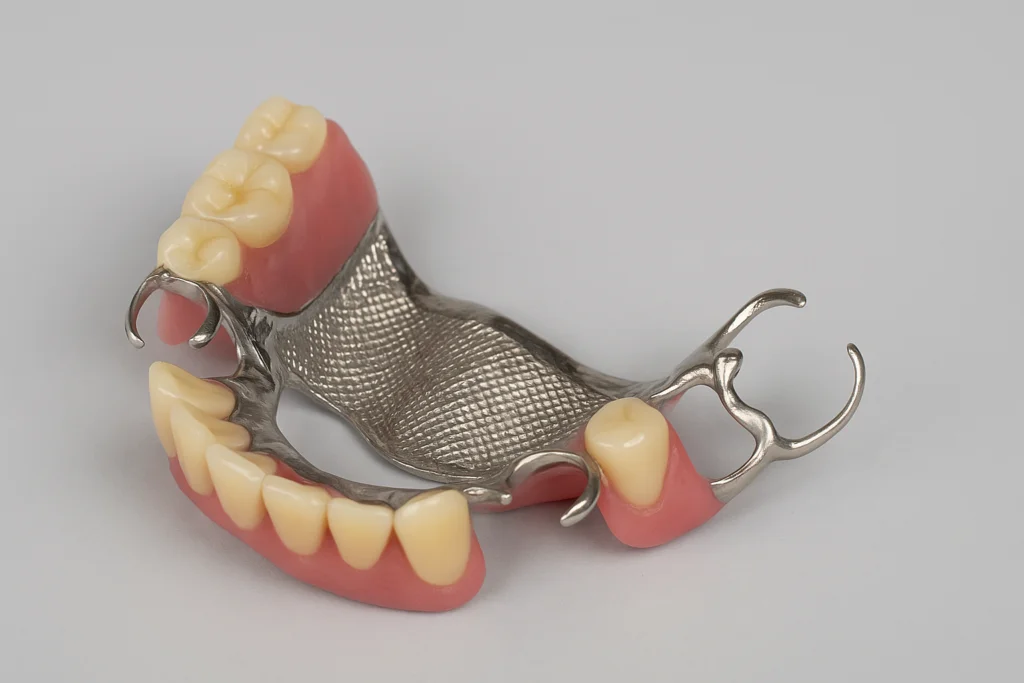Why Cast Metal Partial Dentures Still Matter
When it comes to replacing missing teeth, cast metal partial dentures are still one of the best options. These dentures are made from a metal framework, which gives them excellent strength, durability, and comfort. They’re commonly used to help restore a person’s natural bite, and they last a long time because of the metal construction.
Compared to acrylic dentures, cast metal partials are much stronger. This makes them ideal for long-term wear. Plus, the metal framework is not only durable but also lighter and more comfortable.
That said, the traditional process of making these dentures can be a bit tricky. It involves hand-sculpting wax patterns, which can be time-consuming and prone to errors. This means there’s often a lot of adjusting and tweaking involved.

Common Challenges in Traditional Fabrication
Making cast metal partial dentures the old-fashioned way can be difficult. Here are some of the challenges:
- Manual Waxing Errors: When creating the wax patterns by hand, it’s easy to make mistakes. These errors can lead to inconsistencies and require extra work to fix.
- Repetitive Work: Sculpting the wax, adjusting it, and reworking it can be very time-consuming and repetitive.
- Risk of Model Loss or Damage: Physical models can be lost or damaged during handling, which affects the quality of the final denture.
- Lack of Digital Storage: Traditional methods don’t allow you to store or reuse models easily. So if you need to make adjustments, you often have to start from scratch.
How 3D Printing Fits into the Workflow
3D printing changes the game for partial denture fabrication. It allows dental labs to keep the metal casting benefits while improving accuracy, speed, and ease of modification.
Here’s how it works:
- Scan the Patient’s Mouth: First, a digital scan of the patient’s mouth is done.
- CAD Design: The next step is to design the denture framework using CAD (computer-aided design) software.
- 3D Printing: Once the design is ready, it’s printed using a 3D printer (usually DLP or SLA) with materials like castable resins or wax-like resins.
- Metal Casting: The printed pattern is used in traditional metal casting, so you still get that high-quality metal framework.
This digital approach speeds up the whole process, allows for precise adjustments, and makes everything much easier to repeat.

Key Benefits of Using 3D Printing
Let’s take a look at the benefits of using 3D printing in partial denture fabrication:
- High Precision: 3D printing achieves super-accurate, micron-level detail. This ensures that the denture fits the patient perfectly.
- Time-Saving: What used to take days can now be done in 1-2 days, cutting production time significantly.
- Repeatability & Storage: Once a design is created, it’s stored digitally. This means you can reuse it for future cases without re-sculpting everything.
- Design Flexibility: CAD software makes it easy to adjust the design. Whether the patient needs slight modifications or the dentist requests changes, it’s all easy to handle.
- Cost Efficiency: Sure, there’s an initial cost to set up digital tools, but in the long run, this approach saves a lot of money. Fewer errors, less labor, and faster production all add up to lower costs.

Typical Digital Workflow in a Dental Lab
Here’s what a typical digital workflow in a dental lab looks like when making cast metal partial dentures:
- Scan the Patient’s Mouth: Either a digital scan of the patient’s mouth or a physical model is used.
- CAD Design: Using CAD software, the denture framework is designed.
- 3D Print the Model: The design is printed with high-precision 3D printers in materials like castable resins or wax-like resins.
- Metal Casting: The printed model is used in the traditional metal casting process to create the metal framework.
- Polishing & Final Assembly: After casting, the metal framework is polished and assembled to make sure it fits perfectly and functions properly.
Real-World Results from Dental Labs
Dental labs around the world have adopted 3D printing for making partial dentures, and the results are impressive. Here’s a real-life example:
Case Study: Time Savings and Better Precision
A dental lab in Europe switched from traditional wax patterns to 3D printed castable resins for partial denture frameworks. The results?
- Production time dropped by 30–50%: What used to take 4-5 days now takes just 2-3 days.
- Fewer manual errors: Thanks to the precise digital designs and micron-level printing, there were fewer fitting issues.
- Improved customer satisfaction: Faster production and more consistent quality led to positive feedback and more repeat orders.
Before vs. After Digital Transition
| Workflow Stage | Traditional Method | With 3D Printing |
|---|---|---|
| Wax Pattern Creation | 1-2 hours (manual) | 30-45 minutes (digital print) |
| Turnaround Time | 4-5 days | 2-3 days |
| Remake Requests | Frequent (fit issues) | Rare (precise fit) |
| Record Archiving | Physical models only | Digital files saved |


